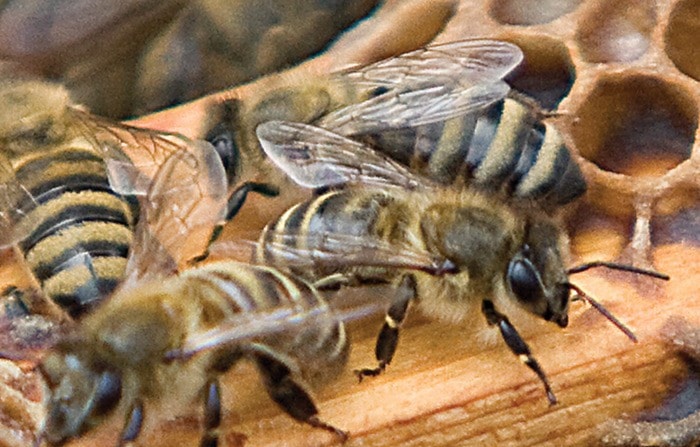Banning neonicotinoid pesticides from use in Canada won’t solve all the problems that are bugging bees, says an SFU biologist who works with blueberry growers in Pitt Meadows who use the neuro-toxin.
The effects of the pesticide are serious enough, however, that Elizabeth Elle now believes it should be stricken from the list of farm chemicals.
Elle was commenting after the release this week of a review that said neonicotinoid pesticides are killing a wide range of insects and are considered “a key factor” in the decline of bees.
The Task Force on Systemic Pesticides was conducted by 50 scientists and reviewed 800 separate studies.
That review confirmed “concerns about the harmful effects of neonics on bees and other pollinators and also highlights serious risks to many other beneficial species, including butterflies, earthworms and birds,” said the David Suzuki Foundation.
Elle, though, says removing the chemical isn’t enough by itself to solve all bee problems. Disease, mites, weather and loss of habitat can all reduce bee populations, which are relied upon to fertilize blossoms, which, in return, produce fruit.
“This is not a smoking gun,” she said. “There’s not going to be a silver bullet.”
Nevertheless, the effects of neonics are serious enough they should be banned, she added.
In addition to outright killing of bees, the long-term effects of impaired nerve function in bees can hurt pollination because the bees can’t navigate properly and are more vulnerable to disease.
“These effects are not what we usually test for when approving pesticides.”
Last year, Europe imposed a moratorium on neonicotinoids and conservation groups such as the Suzuki foundation, Wilderness Committee and the Sierra Club Canada want the same here.
Neonics were developed in 1991 and brought into commercial use in that decade. Neonics can be applied at the root (as seed coating or soil drench) or sprayed on to crop foliage. The insecticide toxin remains active in the soil or plant for many months.
Farmers liked such qualities because it reduced the amount of spraying and contamination and allowed for safer application.
“Everybody loved neonics. They worked really well,” Elle said.
Another benefit is that when the plants grew from seed, the pesticide was retained within the plant itself. For blueberry plants, the neonics are sprayed on to the leaves.
But no one anticipated that beneficial insects would be harmed by ingesting the pesticide when pollinating.
Neonicotinoid pesticides work like other neuro-toxic pesticides, by interfering with the nervous system that affects bodily functions, just as nerve gas affects humans.
“You can see why they work so well then because the plant is poison to anything that would eat it.
“They are absolutely, definitely expressed in the flowers. You take that pollen home and you feed it to your larvae, and your larvae are exposed to neonics,” Elle said.
That works well if it’s a caterpillar looking for a free meal, but not so well if it’s a bee on which farmers are counting to do their job.
“The study definitely shows that we do have evidence now. We have to stop denying it,” Elle added. “I do think it’s time to ban them.”
By absorbing the chemical, insects lose the ability to learn, to navigate, to return to their hives and don’t pollinate as well.
Elle isn’t calling for a ban on all pesticides. Growers need them. When there are huge sections of blueberries or cranberries, outbreaks can occur.
“My growers, they need pesticides. They need something to use,” she said. “These guys need options. They don’t want to spread something that’s going to hurt pollinators on their farms.”
Debbie Etsell, with the B.C. Blueberry Council, added that farmers rely on a healthy population of bees to pollinate their crops for fruit production.
“We do not have prevalent use of neonicotinoids in our industry and have not heard of any difficulty with crops being pollinated.”
Growers who are applying pesticides must follow practices set out by Pesticide Management Regulation Agency.
“There is to be no use of this when bees are in the fields whatsoever. We really rely on bees heavily.”
It’s a question of balance – of controlling pests while preserving bees.
Elle said that wild bees, such as bumble bees, are crucial in pollinating fruit crops because they shake the pollen loose, allowing fertilization, something honey bees can’t do. They can also fly in inclement weather.
Biologists have learned that providing wild or semi-wild areas close to berry fields encourages more bumble bees.
“If there are more bumble bees, they get more fruit,” Elle said.
“If you have a lot of wild bumble bees on your farm, you wind up making more money because you make more fruit.”
Elle works with only blueberry growers, but said she’d be shocked if cranberry growers in Pitt Meadows were not also using the neonics.
The task force will publish its study this summer in the science journal Environmental Science and Pollution Research.
